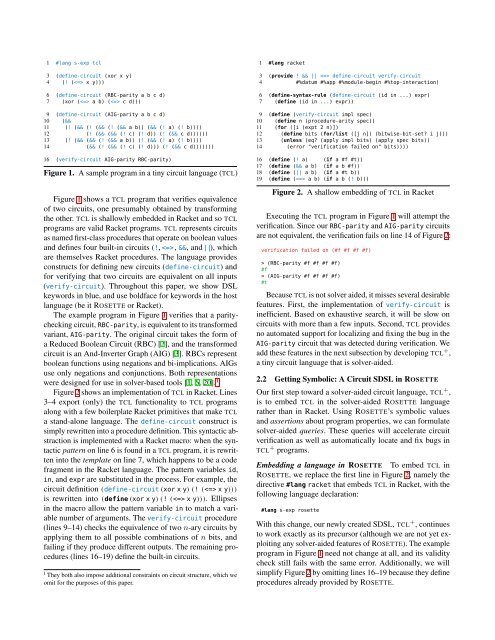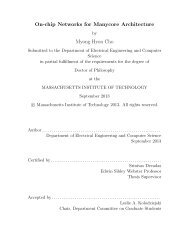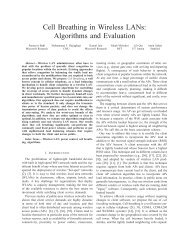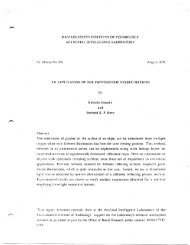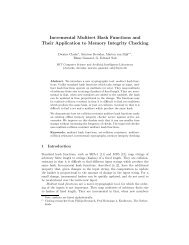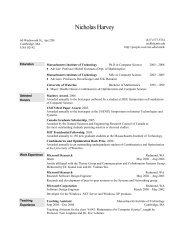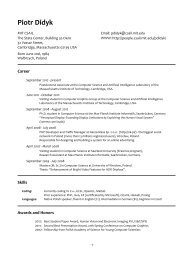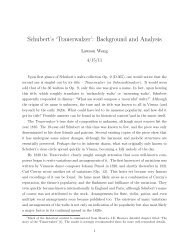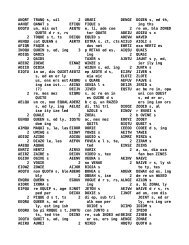Growing Solver-Aided Languages with ROSETTE - People - MIT
Growing Solver-Aided Languages with ROSETTE - People - MIT
Growing Solver-Aided Languages with ROSETTE - People - MIT
You also want an ePaper? Increase the reach of your titles
YUMPU automatically turns print PDFs into web optimized ePapers that Google loves.
1 #lang s-exp tcl<br />
3 (define-circuit (xor x y)<br />
4 (! ( x y)))<br />
6 (define-circuit (RBC-parity a b c d)<br />
7 (xor ( a b) ( c d)))<br />
9 (define-circuit (AIG-parity a b c d)<br />
10 (&&<br />
11 (! (&& (! (&& (! (&& a b)) (&& (! a) (! b))))<br />
12 (! (&& (&& (! c) (! d)) (! (&& c d))))))<br />
13 (! (&& (&& (! (&& a b)) (! (&& (! a) (! b))))<br />
14 (&& (! (&& (! c) (! d))) (! (&& c d)))))))<br />
16 (verify-circuit AIG-parity RBC-parity)<br />
Figure 1. A sample program in a tiny circuit language (TCL)<br />
Figure 1 shows a TCL program that verifies equivalence<br />
of two circuits, one presumably obtained by transforming<br />
the other. TCL is shallowly embedded in Racket and so TCL<br />
programs are valid Racket programs. TCL represents circuits<br />
as named first-class procedures that operate on boolean values<br />
and defines four built-in circuits (!, , &&, and ||), which<br />
are themselves Racket procedures. The language provides<br />
constructs for defining new circuits (define-circuit) and<br />
for verifying that two circuits are equivalent on all inputs<br />
(verify-circuit). Throughout this paper, we show DSL<br />
keywords in blue, and use boldface for keywords in the host<br />
language (be it <strong>ROSETTE</strong> or Racket).<br />
The example program in Figure 1 verifies that a paritychecking<br />
circuit, RBC-parity, is equivalent to its transformed<br />
variant, AIG-parity. The original circuit takes the form of<br />
a Reduced Boolean Circuit (RBC) [2], and the transformed<br />
circuit is an And-Inverter Graph (AIG) [3]. RBCs represent<br />
boolean functions using negations and bi-implications. AIGs<br />
use only negations and conjunctions. Both representations<br />
were designed for use in solver-based tools [1, 6, 20]. 1<br />
Figure 2 shows an implementation of TCL in Racket. Lines<br />
3–4 export (only) the TCL functionality to TCL programs<br />
along <strong>with</strong> a few boilerplate Racket primitives that make TCL<br />
a stand-alone language. The define-circuit construct is<br />
simply rewritten into a procedure definition. This syntactic abstraction<br />
is implemented <strong>with</strong> a Racket macro: when the syntactic<br />
pattern on line 6 is found in a TCL program, it is rewritten<br />
into the template on line 7, which happens to be a code<br />
fragment in the Racket language. The pattern variables id,<br />
in, and expr are substituted in the process. For example, the<br />
circuit definition (define-circuit (xor x y) (! ( x y)))<br />
is rewritten into (define (xor x y) (! ( x y))). Ellipses<br />
in the macro allow the pattern variable in to match a variable<br />
number of arguments. The verify-circuit procedure<br />
(lines 9–14) checks the equivalence of two n-ary circuits by<br />
applying them to all possible combinations of n bits, and<br />
failing if they produce different outputs. The remaining procedures<br />
(lines 16–19) define the built-in circuits.<br />
1 They both also impose additional constraints on circuit structure, which we<br />
omit for the purposes of this paper.<br />
1 #lang racket<br />
3 (provide ! && || define-circuit verify-circuit<br />
4 #%datum #%app #%module-begin #%top-interaction)<br />
6 (define-syntax-rule (define-circuit (id in ...) expr)<br />
7 (define (id in ...) expr))<br />
9 (define (verify-circuit impl spec)<br />
10 (define n (procedure-arity spec))<br />
11 (for ([i (expt 2 n)])<br />
12 (define bits (for/list ([j n]) (bitwise-bit-set? i j)))<br />
13 (unless (eq? (apply impl bits) (apply spec bits))<br />
14 (error "verification failed on" bits))))<br />
16 (define (! a) (if a #f #t))<br />
17 (define (&& a b) (if a b #f))<br />
18 (define (|| a b) (if a #t b))<br />
19 (define ( a b) (if a b (! b)))<br />
Figure 2. A shallow embedding of TCL in Racket<br />
Executing the TCL program in Figure 1 will attempt the<br />
verification. Since our RBC-parity and AIG-parity circuits<br />
are not equivalent, the verification fails on line 14 of Figure 2:<br />
verification failed on (#f #f #f #f)<br />
> (RBC-parity #f #f #f #f)<br />
#f<br />
> (AIG-parity #f #f #f #f)<br />
#t<br />
Because TCL is not solver aided, it misses several desirable<br />
features. First, the implementation of verify-circuit is<br />
inefficient. Based on exhaustive search, it will be slow on<br />
circuits <strong>with</strong> more than a few inputs. Second, TCL provides<br />
no automated support for localizing and fixing the bug in the<br />
AIG-parity circuit that was detected during verification. We<br />
add these features in the next subsection by developing TCL + ,<br />
a tiny circuit language that is solver-aided.<br />
2.2 Getting Symbolic: A Circuit SDSL in <strong>ROSETTE</strong><br />
Our first step toward a solver-aided circuit language, TCL + ,<br />
is to embed TCL in the solver-aided <strong>ROSETTE</strong> language<br />
rather than in Racket. Using <strong>ROSETTE</strong>’s symbolic values<br />
and assertions about program properties, we can formulate<br />
solver-aided queries. These queries will accelerate circuit<br />
verification as well as automatically locate and fix bugs in<br />
TCL + programs.<br />
Embedding a language in <strong>ROSETTE</strong> To embed TCL in<br />
<strong>ROSETTE</strong>, we replace the first line in Figure 2, namely the<br />
directive #lang racket that embeds TCL in Racket, <strong>with</strong> the<br />
following language declaration:<br />
#lang s-exp rosette<br />
With this change, our newly created SDSL, TCL + , continues<br />
to work exactly as its precursor (although we are not yet exploiting<br />
any solver-aided features of <strong>ROSETTE</strong>). The example<br />
program in Figure 1 need not change at all, and its validity<br />
check still fails <strong>with</strong> the same error. Additionally, we will<br />
simplify Figure 2 by omitting lines 16–19 because they define<br />
procedures already provided by <strong>ROSETTE</strong>.


